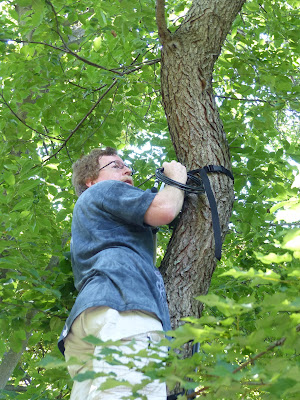Bat Research at Bethpage State Park
 In
2016, Bethpage State Park became one of the few sites selected for the Long Island Bat Initiative. This is a
research study conducted by biologist and bat specialist, Dr. Thomas Gordon, from Suffolk Community College. His main focus is to understand the diversity of bat species living in the local area.
In
2016, Bethpage State Park became one of the few sites selected for the Long Island Bat Initiative. This is a
research study conducted by biologist and bat specialist, Dr. Thomas Gordon, from Suffolk Community College. His main focus is to understand the diversity of bat species living in the local area.  Gordon’s work begins with
mapping out potential bat havens across the island and installing bat detection
devices at these locations. Areas of interest include parks, golf courses,
cemeteries and other habitats with a nearby water source and ample, open space.
The equipment that Dr. Gordon installs, operates
using a microphone and a memory card. This can record numerous high frequency (ultrasonic)
calls from bats at any given time. After a few weeks, the devices are
removed from the sites and the recordings are translated by a program that distinguishes
which type of bats were present; believe it or not, each bat species makes their own distinctive
call!
Gordon’s work begins with
mapping out potential bat havens across the island and installing bat detection
devices at these locations. Areas of interest include parks, golf courses,
cemeteries and other habitats with a nearby water source and ample, open space.
The equipment that Dr. Gordon installs, operates
using a microphone and a memory card. This can record numerous high frequency (ultrasonic)
calls from bats at any given time. After a few weeks, the devices are
removed from the sites and the recordings are translated by a program that distinguishes
which type of bats were present; believe it or not, each bat species makes their own distinctive
call!
You
may be wondering... Why do bats make so much noise in the first place?
The
answer is navigation. Bats use sound to understand their surroundings in
the dark. When a bat emits a call, the sound wave that is produced bounces off objects
and prey nearby. This act subsequently creates a recognizable echo, which reaches
the bat’s
ears and
provides information (e.g. how big the prey is and how far away it may be). This
unique ability is called ECHOLOCATION.
What
were Dr. Gordon’s findings?
 According
to the recordings of two detectors installed at our park in 2016, one in our picnic area and another on our Green Course, there is a
possibility we have 9 different bat species inhabiting the area or at
least passing through. The species detected were:
According
to the recordings of two detectors installed at our park in 2016, one in our picnic area and another on our Green Course, there is a
possibility we have 9 different bat species inhabiting the area or at
least passing through. The species detected were:
Big brown bat - Eptesicus fuscus (EPFU)
Eastern red bat - Lasiurus borealis (LABO)
Hoary bat - Lasiurus cinereus (LACI)
Silver-haired bat - Lasionycteris noctivagans (LANO)
Eastern small footed myotis - Myotis leibii (MYLE)
Little brown bat - Myotis lucifugus (MYLU)
Northern long-eared myotis - Myotis septentrionalis (MYSE)
Indiana bat - Myotis sodalis (MYSO)
Eastern pipistrelle - Perimyotis subflavus (PESU)
Overall, Big brown bat was the species that had the most recorded calls on both detectors.
While bat data was also collected in 2017, it is still in the process of being evaluated by Dr. Gordon. We believe it will be interesting to make comparisons between yearly data as well as continue to record and translate calls from these detectors in the future. Perhaps we can place the detectors at other locations around our park, to get a better understanding of the bats' habitat ranges and favorable feeding locations.
Why is bat research important?
Unfortunately, in recent years, scientists have discovered that the populations of many North American bat species have dramatically decreased. This is, in part, because of human-induced habitat destruction but also a fungal disease that affects their ability to function normally. This disease is known as white-nose syndrome. Less bats on Long Island can be critically damaging to our ecosystem and human health. Bats are insectivorous; their presence keeps mosquito populations at bay. It is important to note that not having bats around might result in increased insecticide usage, an outcome we must prevent for the sake of our pollinators, birds and environment as a whole. Therefore, Dr. Gordon's study is incredibly important to us and our ecological efforts.
Why is bat research important?
Unfortunately, in recent years, scientists have discovered that the populations of many North American bat species have dramatically decreased. This is, in part, because of human-induced habitat destruction but also a fungal disease that affects their ability to function normally. This disease is known as white-nose syndrome. Less bats on Long Island can be critically damaging to our ecosystem and human health. Bats are insectivorous; their presence keeps mosquito populations at bay. It is important to note that not having bats around might result in increased insecticide usage, an outcome we must prevent for the sake of our pollinators, birds and environment as a whole. Therefore, Dr. Gordon's study is incredibly important to us and our ecological efforts.



Comments
Post a Comment